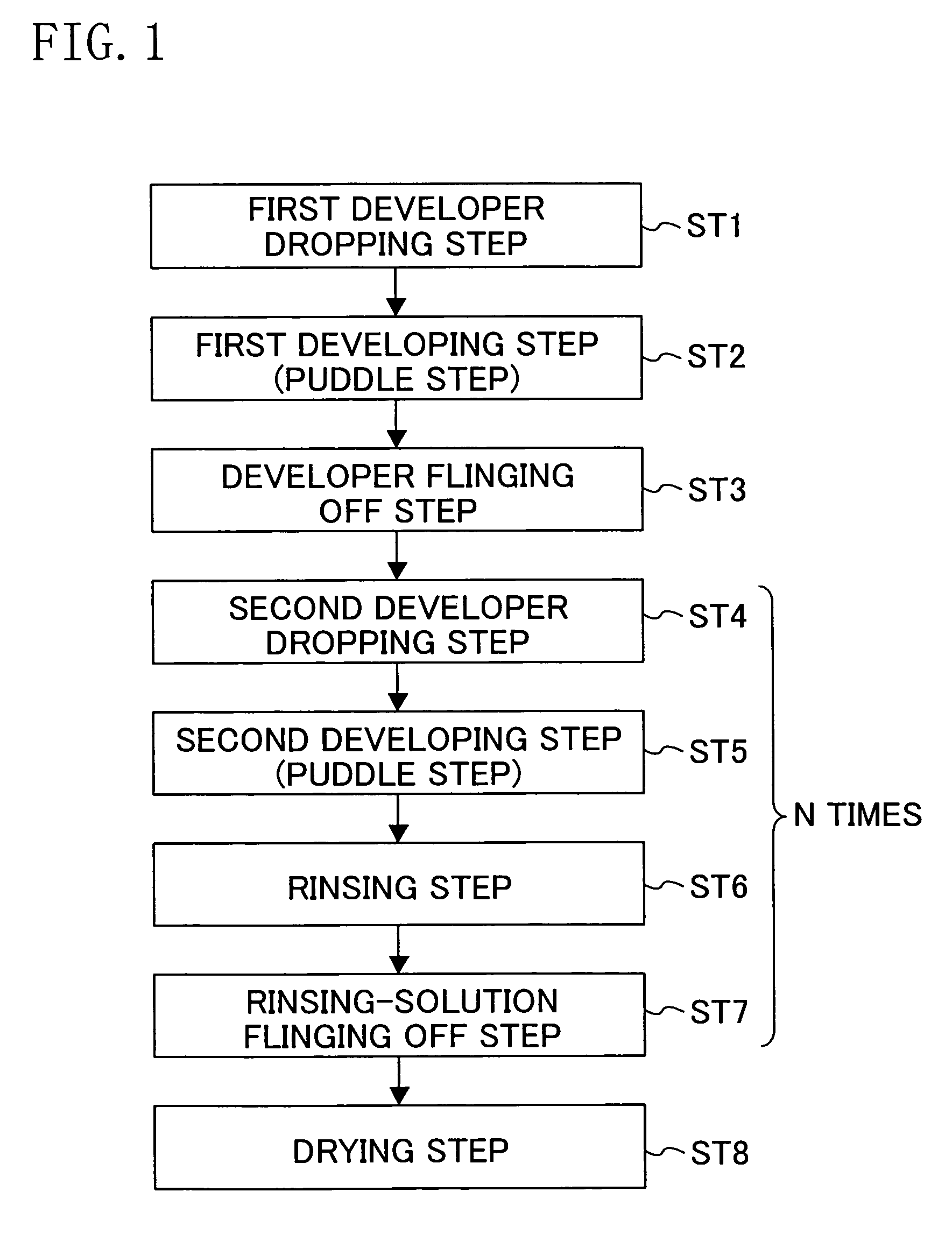Developing method and method for fabricating semiconductor device using the developing method
a technology of developing method and developing method, which is applied in the direction of photomechanical equipment, instruments, photosensitive material processing, etc., can solve the problem of large pattern size variation, and achieve the effect of preventing pattern size variation
- Summary
- Abstract
- Description
- Claims
- Application Information
AI Technical Summary
Benefits of technology
Problems solved by technology
Method used
Image
Examples
embodiment 1
[0043]A first embodiment of the present invention will be described with reference to the drawings.
[0044]FIG. 1 shows a flow of processes in a method for developing a resist according to the first embodiment. FIGS. 2A through 2G are side views schematically showing a method for developing a resist according to the process flow shown in FIG. 1.
[0045]In the first embodiment, so-called multi-stage development is performed. Specifically, a developer is supplied onto a resist film, and then a wafer is rotated without addition of a rinsing solution (pure water) so as to fling off and remove the developer. Thereafter, a developer is supplied onto the resist film again to perform second development. When necessary, third development is performed.
[0046]First, though not shown, the principal surface of the wafer having a diameter of, for example, 20.3 cm (i.e., 8 inches) and made of silicon (Si) is coated with a resist film by a spin coating process.
[0047]Next, a design pattern including a pa...
embodiment 2
[0075]Hereinafter, a developing method for a resist according to a second embodiment of the present invention will be described.
[0076]The second embodiment is also directed to a resist film 2 shown in FIG. 3A and adjacent design patterns having different opening ratios are exposed on the resist film 2.
[0077]The second embodiment is different from the first embodiment in that the rotation speed of the wafer in the developer flinging off step ST3 is set at a half or less of that in the rinsing step in the first embodiment, whereas the rotation speed in a developer flinging off step ST3 is equal to that in a rinsing step but the rotation time is shorter than that in the rinsing step in the second embodiment.
[0078]Specifically, in the second embodiment, in the developer flinging off step ST3, the rotation speed and time are set not to dry a resist film 2 on a wafer 1 and the fling-off time of a developer 4 is set such that the rotation speed is 3000 rpm and the rotation time is set at o...
embodiment 3
[0083]Hereinafter, a third embodiment of the present invention will be described with reference to the drawings.
[0084]FIGS. 8A and 8B and FIG. 9 illustrate cross-sectional structures of respective process steps of a method for fabricating a semiconductor device according to the third embodiment using the developing method for a resist of the first or second embodiment.
[0085]First, as shown in FIG. 8A, a plurality of transistors (field effect transistors) 31 are formed in a wafer (substrate) 30 made of silicon and are isolated from each other by a trench isolation film 32.
[0086]A first insulating film 33A made of, for example, silicon oxide and having a planarized upper surface is formed on the wafer 30 to cover the transistors 31. A plurality of first contact plugs 34A are formed in the first insulating film 33A and electrically connected to source / drain regions of the first transistors 31. A plurality of first interconnections 35A containing an aluminum alloy as a main component ar...
PUM
| Property | Measurement | Unit |
|---|---|---|
| distance | aaaaa | aaaaa |
| diameter | aaaaa | aaaaa |
| diameter | aaaaa | aaaaa |
Abstract
Description
Claims
Application Information
 Login to View More
Login to View More - R&D
- Intellectual Property
- Life Sciences
- Materials
- Tech Scout
- Unparalleled Data Quality
- Higher Quality Content
- 60% Fewer Hallucinations
Browse by: Latest US Patents, China's latest patents, Technical Efficacy Thesaurus, Application Domain, Technology Topic, Popular Technical Reports.
© 2025 PatSnap. All rights reserved.Legal|Privacy policy|Modern Slavery Act Transparency Statement|Sitemap|About US| Contact US: help@patsnap.com



